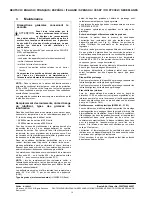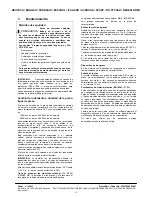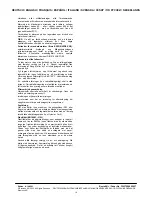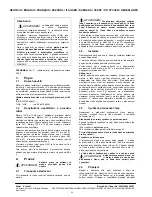
DEUTSCH / ENGLISH / FRANÇAIS / ESPA
Ň
OL / ITALIANO / SVENSKA /
Č
ESKY /
ПО
РУССКИ
/ NEDERLANDS
General note
The data and recommendations
specified in all the instructions
supplied, and in all other related instructions, must always
be observed in order to avoid
hazardous situations
and
the
risk
of possible injury or damage.
These instructions are augmented by supplementary
instructions (yellow), which contain additional information
on the safety measures for electrical machines and
devices. The latter instructions thus augment all submitted
instructions and all other related instructions.
Furthermore, the
pertinent national, local
and
plant-
specific regulations
and
requirements
should be kept
in mind!
Special designs
and
other versions
may vary in
technical details! If in doubt, be sure to contact the
manufacturer, quoting the
type designation
and
serial
number
, or have maintenance work done by one of
SIEMENS Service Centres.
NOTE:
Fig. 2 ... (Spare Parts) see Annex page 35-36
1 Description
1.1 Application
The motors are suitable for operation in dusty and damp
environments. The insulation is tropicalized. If they are
properly stored or installed outdoors, special weatherproofing
measures are not usually required.
Measuring-surface sound-pressure level at 50 Hz
(DIN EN 21 680 Part 1)
1LG4, 1LG6
approx. 51 to 76 dB(A)
1.2
Construction and mode of operation
The 1LG4 and 1LG6 motors are standardly self-ventilated with
own fans. In addition to that the 1LG motors are optionally
either without an own fan (such as fan motors with cooling by
means of a separate fan arranged on the shaft end) or with
external coolling (option G17). The 1PP4 and 1PP6 motors
are equipped with own cooling without any fan.
The feet on foot-mounted motors are cast integrally with the
motor casing or they can be optionally bolted onto the casing
(option K11 / see fig. 2).
Rearranging the feet (e.g. for changing the position of the
terminal box) is possible for options K09, K10 and K11. The
bores and surfaces, necessary for this purpose, are already
machined in a corresponding way.
Where motors with brake are concerned (e.g. option G26),
take into consideration also the brake operating instructions!
These instructions are valid in addition to the operating
instructions of the given motor type. They are not valid for
motors of EEx e series.
2 Operation
Before starting any work on the
machine, be sure to isolate it from
the power supply.
2.1 Transport,
storage
The motors should always be lifted at both
lifting eyes
during
transport.
For lifting machine sets (such as built-on gearboxes, fan
units), always use the lifting eyes or
lifting pegs provided! Machine sets
may not be lifted by suspending the
individual machines! Check the lifting capacity of the
hoist!
WARNING
WARNING
If, after delivery, the motors are stored for more than 3 years
under favourable conditions (kept in a dry place free from dust
and vibration) prior to commissioning, the bearings should be
regreased respectively exchanged.
Under unfavourable conditions, this period is considerably
shorter.
If necessary, the insulation resistance of the winding should
be checked, see Section 2.5.
2.2 Installation
After installation,
screwed-in lifting eyes
should either be
removed or tightened down.
In the
case of motors with shaft end facing upwards or
downwards
, measures must be taken to ensure that no water
can penetrate into the upper bearing.
In the case of
terminal boards
with 6 terminals, the top part
of the terminal box can be turned through 4 x 90 degrees. For
terminal boards with 9 terminals, it can be turned through 180
degrees.
Quiet running
Stable foundations or mounting conditions, exact alignment of
the motors and a well-balanced transmission element are
essential for quiet vibration-free running. Before starting an
assembly, the contact surfaces for engine assembly should be
cleaned and checked for flatness. To avoid stress in the
engine feet, the total flatness of the contact surfaces of the
base should not exceed 0.2 mm. The contact surfaces to be
welded should be smoothed by grinding to reach the flatness
required. If sheets are used for padding to set an elevation
and avoid stress in the engine, they should be made from
rolled stock of an appropriate size. It may also be necessary
to balance the rotor with transfer element.
2.3 Balancing,
transmission
elements
A suitable device should always be used for fitting and
removing the transmission elements (coupling halves, pulleys,
pinions) (Fig. 7).
As standard, the rotors are dynamically balanced with the
half featherkey inserted.
The type of balance is marked on the drive end of the shaft
(shaft end face):
(
H
= balanced with
half
featherkey)
(
F
= balanced with
whole
featherkey)
When fitting the transmission element, keep the type of
balance in mind!
Balance with half featherkey
Poor running characteristics can arise in the case of
transmission elements having a length ratio of hub length l to
length of shaft end l
M
< 0.8 and running at speeds of > 1500
rev/min (see Fig. 8). If necessary, re-balancing should be
carried out, e.g. the part of the featherkey T
p
that protrudes
from the transmission element and above the shaft surface
should be cut back.
WARNING
The usual measures should be taken
to guard transmission elements from
touch. If a motor is started up without transmission
element attached, the featherkey should be secured to
prevent it being thrown out.
WARNING
Edition N14-0903
Bestell-Nr. / Order No. 35037000000057
© Siemens AG 2000 All Rights Reserved
DEUTSCH/ENGLISH/FRANCAIS/ESPANNOL/ITALIANO/SVENSKA/
Č
ESKY/
ПО
РУССКИ
/NEDERLANDS
Siemens AG
5





































